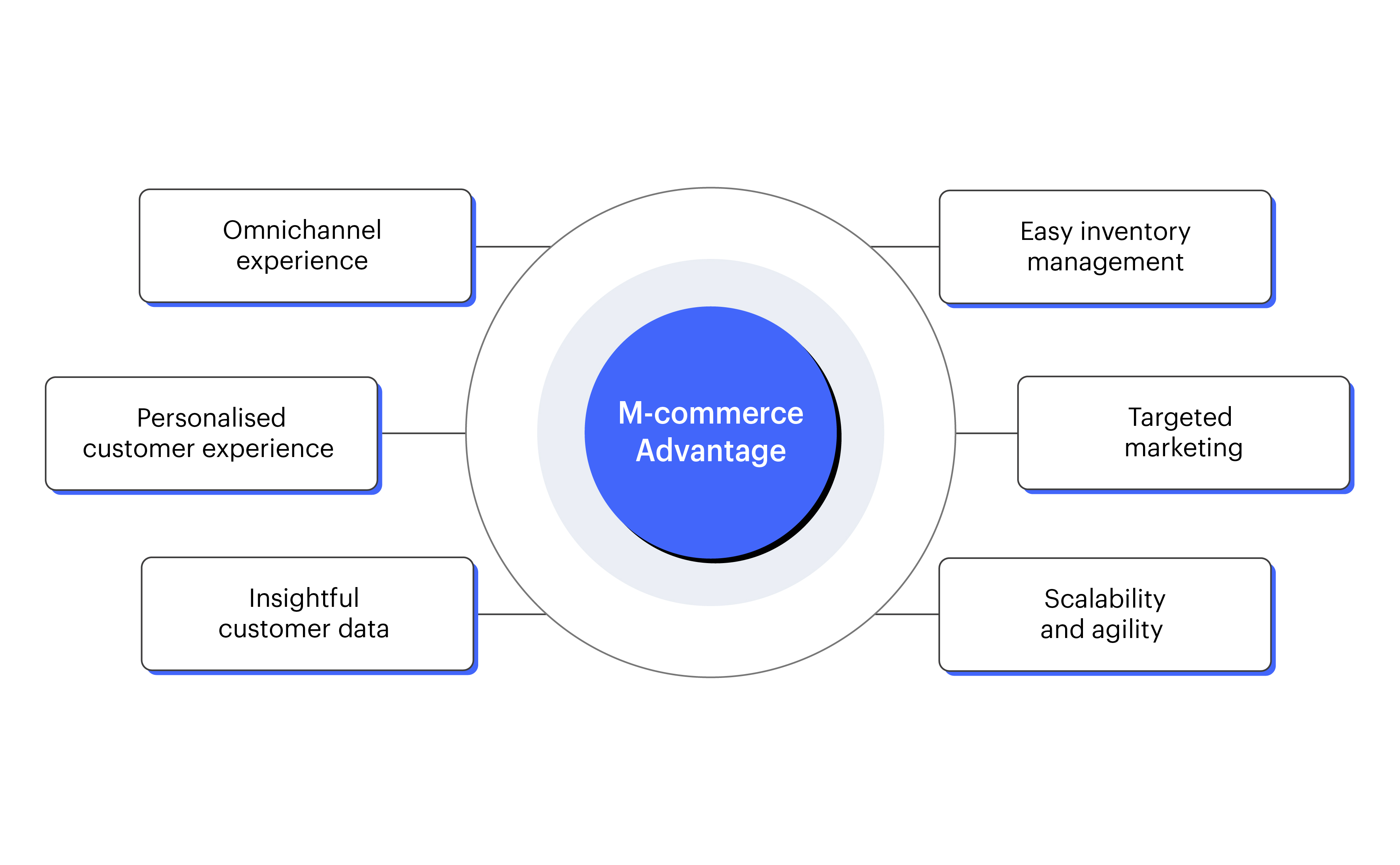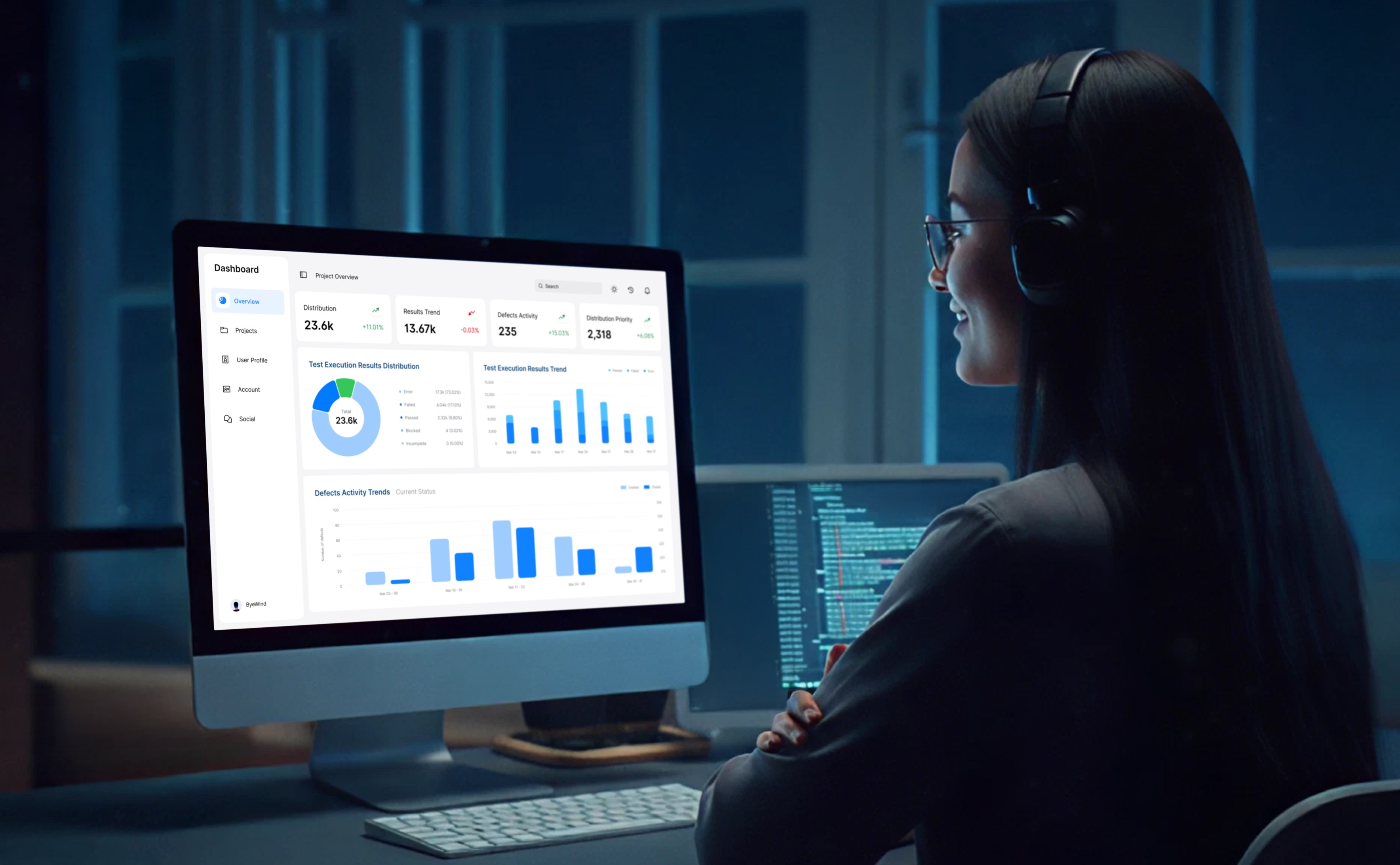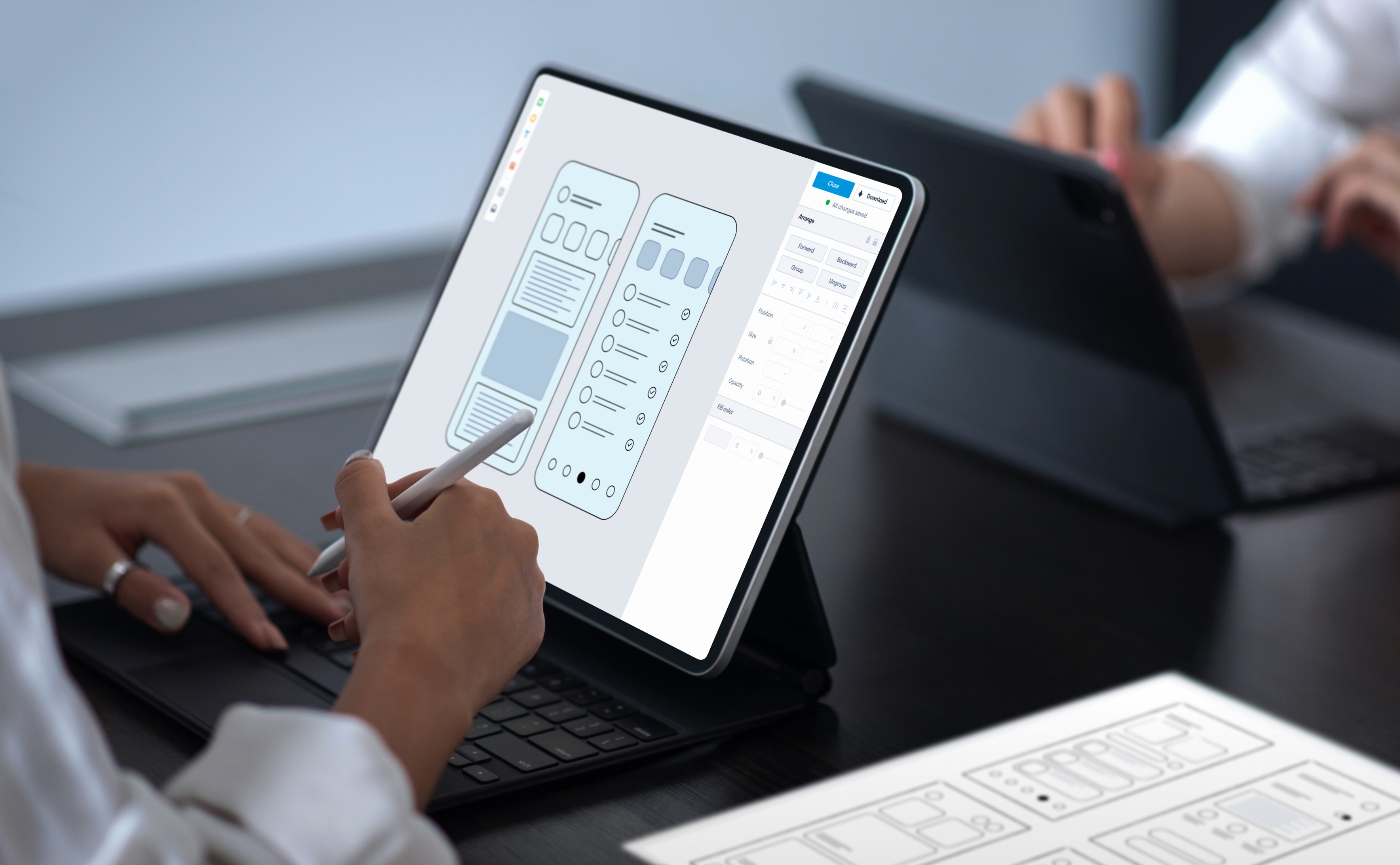Mobile Commerce Explained: What’s Next?

- What is Mobile Commerce?
- Characteristic Features of Mobile Commerce
- Types of Mobile Commerce
- How Does Mobile Commerce Work?
- Mobile Commerce Advantages: Things You Can Count On
- Mobile Commerce Disadvantages: Points You Should Take Care of
- M-Commerce Vs. E-Commerce: Comparison in a Nutshell
- Future of Mobile Commerce: What’s Next?
- The Bottom Line
- What is Mobile Commerce?
- Characteristic Features of Mobile Commerce
- Types of Mobile Commerce
- How Does Mobile Commerce Work?
- Mobile Commerce Advantages: Things You Can Count On
- Mobile Commerce Disadvantages: Points You Should Take Care of
- M-Commerce Vs. E-Commerce: Comparison in a Nutshell
- Future of Mobile Commerce: What’s Next?
- The Bottom Line
Mobile commerce, or m-commerce, denotes every commercial transaction through mobile sites or apps. Mobile commerce is a subcategory of e-commerce or a mobile version of e-commerce.
The mobile commerce segment is evolving rapidly, with the increasing volume of digital device purchases. According to Statista, US mobile phone users spend more than 4 hours on average every day on their mobile phones, excluding phone calls.
Since making purchases on mobile has become highly convenient, people across the globe have been increasingly using tablets and smartphones to buy their favourites. In short, m-commerce involves buying and selling products with mobile devices.
This article explains everything about mobile commerce, how it differs from e-commerce and the different types. We will also discuss the benefits of mobile commerce for businesses and the future it offers the generation ahead.
What is Mobile Commerce?
Mobile commerce, or m-commerce refers to a commercial transactional activity implemented with a mobile device. It uses devices like cellphones, or tablets, to facilitate activities such as payment of bills, online banking, sales of goods and services, and different types of financial transactions.
Social media platforms like Facebook, Instagram and X have a “buy button” feature on their mobile platforms to let users make direct purchases from the stores, which is an example of mobile commerce.
M-commerce establishes personalised connections with customers with features such as location-based services, push notifications, and custom-tailored recommendations. These capabilities develop new opportunities for businesses to drive more sales and boost customer loyalty.
Characteristic Features of Mobile Commerce
- Browsing and purchase: Similar to an e-commerce flow on the desktop, m-commerce works around user browsing apps, clicking through mobile websites, and purchases. This occurs with dedicated apps but can remain a ‘social commerce’ purchase, using social media platforms such as Instagram, TikTok, and Snapchat that offer in-app purchase options.
- Convenience in shopping: Mobile commerce helps shoppers and retail employees be comfortable by reducing in-person interactions and letting businesses continue selling despite store closures, enabling people to shop for their must-haves conveniently.
- Mobile app and wallet payments: There are numerous ways to make an m-commerce purchase, as digital wallets are growing in demand. Rather than inputting credit card information into every individual app, the user’s digital wallet can be loaded and the purchase can be made with a simple click or a thumbprint.
- Digital Content (purchasing & renting): Subscription apps are popular on mobile, mostly with music and video (consider Spotify and Netflix). Users can access a whole content library from the mobile app after paying a subscription fee.
Types of Mobile Commerce
1. Mobile shopping: It lets customers purchase a product with a mobile device via an application like Amazon or a web app. App commerce is a subcategory of mobile shopping—a transaction that happens over a native app.
2. Mobile banking: This denotes online banking designed for handheld technology. It lets customers access brokerage services, manage financial transitions, pay bills and conduct stock trades. This is typically executed via a dedicated and secure app that the banking institution provides. Mobile banking services leverage chatbots, SMS or other conversational app platforms to share alerts and monitor account activities. For instance, the WhatsApp chatbot enables customers to analyse transfers of funds, and account balances, review loans and make real-time transactions using WhatsApp.
3. Mobile payments: Mobile payments are alternatives to conventional payment methods like cash, checks, debit and credit cards. It enables users to purchase products in person with a mobile device. Digital payments like Apple Pay let customers buy products without paying with cash or swiping with a card. Mobile payment apps like PayPal, Venmo, etc., have the same use. Mobile consumers use QR codes to pay through their phones. Mobile payments help users send money directly to the recipient’s cell phone or bank account.
4. Mobile ticketing: With mobile ticketing, users can purchase e-tickets for travel, events, entertainment, etc., on mobile devices. Mobile ticketing reduces the production and distribution costs of paper-based ticketing for operators, transferring the burden to the customer.
5. Mobile chatbots: Mobile chatbots facilitate the simulation and processing of human conversations, enabling humans to communicate with smart assistants like humans.
6. Mobile wallets: Mobile wallets store debit card and credit card information on mobile devices. These offer the convenience of purchasing things in-store or online and accepting payments through the wallet.
How Does Mobile Commerce Work?
With most m-commerce-driven platforms, the mobile device is connected to a wireless network that facilitates online purchases and related transactions. For those who develop an m-commerce application, the core performance indicators to track include the following:
- Total mobile traffic,
- Total application traffic,
- Average order value,
- Value of orders over time
Likewise, tracking mobile add-to-cart helps developers check whether the users turn into customers. Mobile commerce developers might also be interested in logging mobile conversion rates, average page loading times and SMS subscriptions.
Mobile payment products function through a peer-to-peer sharing process. Once a mobile device gets paired with the bank card information of a user, the phone could be waved over the terminal that initiates product payment. Contactless payment with a mobile device uses near-field communication technology.
Mobile Commerce Advantages: Things You Can Count On

Insightful Customer Data
Mobile commerce gathers consumer data and provides great insights into the customer journey. Brick-and-mortar retail enables customers to visit the store, purchase, and leave. It notes very few details and doesn’t reserve anything for statistics and analysis. With mobile commerce, businesses connect with the customer right from the moment they visit the store, choose the products and make a purchase.
Personalised Customer Experience
By collecting customer data with tools such as artificial intelligence, brands can personalise the customer experience and offer curated discounts. Collecting data like location and purchase history lets brands segment their customer base. Businesses that personalise customer experiences are highly likely to attract and retain their customers.
Omnichannel Experiences
Omnichannel involves offering transactions across different channels. Mobile commerce lets businesses use various channels to reach customers, like physical and online stores. For instance, customers who can’t access brick-and-mortar stores due to geographical constraints or related reasons can buy, order, and make payments across mobile platforms.
Easy Inventory Management
Managing business inventories is one of the major benefits of mobile commerce. This helps stores identify which products should be restocked and which consumers don’t purchase quickly. This data can also foster better decision-making since companies can invest in products and customers are more likely to shop.
Targeted Marketing
Mobile commerce persuades brands to develop targeted marketing campaigns for particular times and consumers. With consumer data and history, businesses can make more effective advertisements that push customers to make purchase decisions. Targeted marketing can build high sales revenue since customers might be interested in personalised advertisements.
Scalability and Agility
Through m-commerce, you can make business scale better and quicker for all its parts, such as marketing and inventory. This lets them leverage m-commerce to enhance customer support systems and automation. Scalability and agility also help businesses adapt to the evolving market dynamics that keep them competitive.
Mobile Commerce Disadvantages: Points You Should Take Care of
Highly Competitive Marketplace
Recently, many businesses have shifted their focus to success and investment in m-commerce. In this era, you can come across thousands of existing competitors coming our way. As a store owner, you should find a highly targeted or niche market to gain a competitive advantage.
Customer Privacy
When customers offer more access to their data, businesses adopt a higher responsibility to secure personal information. You should ensure that your business and your partners follow strict user protection terms. Thus, make it transparent to customers about what data is shared, gathered and stored.
M-Commerce Vs. E-Commerce: Comparison in a Nutshell
Electronic commerce (e-commerce) defines Internet-enabled buying and selling of goods or services. While both e-commerce and m-commerce are similar, the difference between m-commerce and e-commerce is shown in the table below:
| E-Commerce | M-Commerce | |
| Mobility | Reduces mobility when performed via desktop or fixed devices. | Greater mobility as it is used anywhere and only through handheld devices with an active connection. |
| Location Tracking | Limits the location tracking capabilities when used on a non-mobile device. This affects the targeted advertising strategies. | Can track locations with Wi-Fi and GPS-based technologies for location-specific content and personalised recommendations. Example: push notifications for personalised discounts when users walk past a specific store. |
| Security | Credit cards are used for payments, which are riskier compared to other online payment methods, despite multifactor authentication. | M-commerce prevents certain security gaps with additional measures like biometric authentication, quick response, mobile wallets, QR codes and cryptocurrencies. |
| Examples | Online retail stores like eBay and Amazon. | Mobile payment apps such as Apple Pay and mobile banking. |
| Marketing Approach | Includes different marketing channels like Search Engine Optimisation (SEO) and Social Media Marketing. | Uses mobile-specific marketing tactics such as push notifications, SMS marketing, etc. |
| Integration Capabilities | Enables seamless integration with online systems such as Customer Relationship Management (CRM) and Inventory Management. | Demands integration with mobile-specific features such as GPS and camera functionalities. |
| Design | Depends on responsive web design to maintain an optimal user experience. | It focuses on mobile-friendly design and intuitive navigation for small screens. |
Future of Mobile Commerce: What’s Next?
- Social Commerce
Social media platforms have been the right choice for users to discover new brands and products through posts, stories, influencer recommendations and videos. It helps users purchase via a mobile app with shoppable social media posts. When a user taps a product, they can view a price tag and basic product information. Shoppers can buy items without leaving the application, minimising the friction between finding a product and finishing a purchase. Businesses can repost user-generated content to offer social evidence or interact with the audience through live-streaming to implement time-limited promotions or invoke interest in a new product.
- Voice Commerce
Voice-driven purchases have seen a huge surge. Speaking is faster than typing; hence, purchases can be made faster. Most mobile devices feature built-in voice assistants, which enable users to inquire about items hands-free. Voice assistants can share links to the product pages that match users’ queries, which enables to complete mobile-enabled purchases.
- Mobile Chatbots
Earlier, users started a web chat whenever they had concerns or couldn’t find a product. Sophisticated mobile chatbots are similar to stand-in shopkeepers who forecast what products can interest the customer, process orders and accept mobile payments. Chatbots can also answer product-related queries or recommend higher-tier products.
- One-Click Ordering
One-click ordering is an easy checkout process that utilises the existing payment of a shopper and the shipping information linked to their account to enable a one-click purchase. One-click ordering is useful for customers who purchase the same items frequently, which makes the reordering process instantaneous. Mobile users who experience limited time and screen space can get the most from its simplicity.
- Video Content
Videos grab attention compared to static images or text, which results in high engagement rates. Businesses can showcase their products in action or answer queries through live-streamed Q&A sessions. Social media video content can be effective in engaging audiences across mobile devices. Businesses that offer complex technical solutions or lifestyle products can post video tutorials or webinars to portray themselves as industry experts.
The Bottom Line
M-commerce offers a range of benefits to consumers and businesses alike. As a business, mobile commerce helps you reach more customers, while as a customer, you can complete payment transactions and purchases seamlessly.
While it is a win/win for both sides, it is essential to give the best experience to the customers with advanced technology. Developing mobile commerce applications diligently with due adherence to current market trends and consumer behaviour patterns requires the help of a mobile app development company.
At WAC, we offer dedicated web app development, mobile app development services and mobile commerce development solutions. Choose WAC to make your projects stand out and serve the best for both customers and businesses.
FAQ
Discover Digital Transformation
Please feel free to share your thoughts and we can discuss it over a cup of tea.










